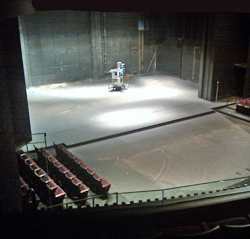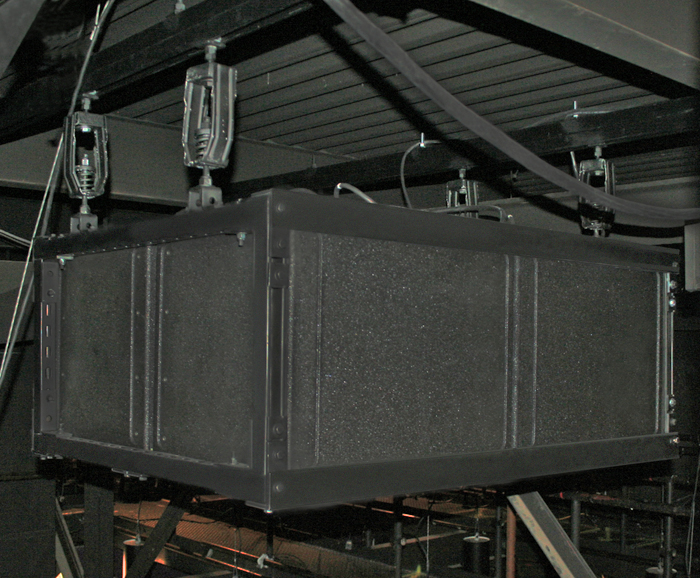
Complete Isolation
Subwoofer selection and location proved to be another challenging facet of the project. These too were required to be “up and out of the way,” but the I-beam couldn’t be further modified, and the structure immediately above it was too congested.
Malek scouted for alternative locations, considering various subwoofer models and configurations, again using modeling to help predict results.
A centrally located position, both in relation to the catwalks as well as the theatre below, was identified and found to be feasible from an acoustic perspective, and further, it didn’t impede or otherwise impact any of the lighting fixtures and other elements in the grid.
However, it too needed infrastructure, this time in the form of a custom frame of back-to-back channel strut beams across the span.
The steel frame was designed to accommodate four Alcons BF115i (install version) subwoofers, each with a single front-loaded, 15-inch long-excursion cone driver, tightly packed, two next to two, firing downward. Every surface of the frame that comes in contact with a subwoofer is lined with 1/4-inch rubber gasket so that there’s no metal to wood vibration. Further, heavy-duty springs at the attachment points to the beams serve to provide additional vibration isolation from the surrounding structure.
“From day one, wanted to make sure this didn’t cause any problems and so went all-in with the structural design,” Malek notes. “It’s completely isolated from the structural steel of the building, so it’s absolutely silent in terms of any additional noise and sympathetic vibrations.”

Getting these larger cabinets in place at the ceiling level wasn’t exactly a cakewalk. They were brought up to the catwalk level via a tall scaffolding erected on the stage, and from there were wrangled into the steel frame. It also shouldn’t go overlooked that a whole lot of planning and subsequent work went into cabling the entire loudspeaker contingent.
Four recently released Alcons Sentinel 3 amplifier-processors drive all loudspeakers, mounted in a rack positioned by the main door to the catwalk area to keep cable runs at an acceptable length while also being easy to access. All parameters can be dialed in and accessed via the front panel on these units, and they can also be remotely adjusted and controlled via networked PC.
At the heart of each 2RU Sentinel 3 is a SHARC digital processor joined by proprietary class D amplifier stages. It has 192 kHz capable AES/EBU inputs, custom-designed sample-rate conversion, and remote-selectable input sensitivity. Loudspeaker DSP functionality includes a 6-band parametric per channel, delay, and factory presets for all Alcons systems and configurations.
“Sentinel is just a phenomenal package, and it’s perfectly matched with the loudspeakers,” Malek states. “There aren’t many amplifier/control options with this type of capability, and they significantly enhance clarity.”
Smooth Transitions
The system’s remaining primary component is a Yamaha M7CL digital console that anchors the front of house position that’s centrally located on the main floor. Landes notes that this unit continues to perform well, but may be subject to an upgrade to a newer model at a later date.
Via an option card on the console, all audio signal (12 channels) is sent via AES/EBU to the Sentinel amplifier/controllers. “It’s a very crisp, sharp, clean way to handle the signal, especially in relation to analog,” Malek says. “Digital not only enhances things sonically, especially with respect to speech intelligibility, but it’s also cut way down on the infrastructure that would have been required to run analog signal cabling through this EMI & RFI jungle that comprises the catwalk space.”
The digital advantage also applied to the system tuning and optimization process, with the sound team able to make adjustments from within the venue rather than needing to run back and forth to the racks or posting someone full-time at the racks and communicating via radios.
“We performed extensive measurements – edge to edge, top to bottom, across the balcony – and there’s very little variation in the overall sound pressure level of the entire area,” Malek says. “It’s amazing how smooth it is. With compression driver/horn systems, you typically see a lot variations and major notches due to coupling in the crossover range, as well as the coverage of the horn versus that of the woofer as they narrow in the upper range of the crossover – it’s the typical ‘wooshing’ sound we’ve all heard while walking through coverage. This isn’t as noticeable when you’re seated, but it’s still a factor.
“Then in the effort to eliminate this lobing problem, you typically work it, and work it some more, crossover points, slopes, delays and so on, but it’s a challenge and rarely feels quite ‘done’,” he concludes. “What we’ve got here is invisible transition between the loudspeakers, appropriately as invisible as the actual loudspeakers are to the eye. It’s what the ribbon tweeter brings to the occasion, and in our view, it’s spectacular.”
Keith Clark is editor in chief of ProSoundWeb and Live Sound International.
